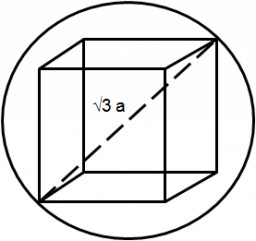Magnified cube
If the lengths of the cube's edges are extended by 5 cm, its volume will increase by 485 cm3. Determine the surface of both the original and the magnified cube.
Final Answer:

Tips for related online calculators
Are you looking for help with calculating roots of a quadratic equation?
Do you have a linear equation or system of equations and are looking for its solution? Or do you have a quadratic equation?
Tip: Our volume units converter will help you convert volume units.
Do you have a linear equation or system of equations and are looking for its solution? Or do you have a quadratic equation?
Tip: Our volume units converter will help you convert volume units.
You need to know the following knowledge to solve this word math problem:
algebraarithmeticsolid geometryplanimetricsUnits of physical quantitiesGrade of the word problem
We encourage you to watch this tutorial video on this math problem: video1
Related math problems and questions:
- Prism
 Three cubes are glued into a prism. The sum of the lengths of all its edges is 487 cm. What is the length of one edge of the original cube?
Three cubes are glued into a prism. The sum of the lengths of all its edges is 487 cm. What is the length of one edge of the original cube? - Determine: 10182
 The lengths of the edges of two cubes are in the ratio 1:2, determine: a) the ratio of the area of the wall of the smaller cube to the area of the wall of the larger cube. b) the ratio of the surface of the smaller cube to the surface of the larger cube.
The lengths of the edges of two cubes are in the ratio 1:2, determine: a) the ratio of the area of the wall of the smaller cube to the area of the wall of the larger cube. b) the ratio of the surface of the smaller cube to the surface of the larger cube. - Determine 7488
 The lengths of the edges of the two cubes are in the ratio 2:3. Determine how many times the surface of the larger cube is larger than the surface of the smaller cube.
The lengths of the edges of the two cubes are in the ratio 2:3. Determine how many times the surface of the larger cube is larger than the surface of the smaller cube. - Cube
 The sum of lengths of cube edges is 56 cm. What are its surface and volume?
The sum of lengths of cube edges is 56 cm. What are its surface and volume? - Calculate 81841
 The sum of the lengths of all the cube's edges is 60 cm. How to calculate its volume?
The sum of the lengths of all the cube's edges is 60 cm. How to calculate its volume? - GP - edge lengths
 The block edge lengths are made up of three consecutive GP members. The sum of the lengths of all edges is 84 cm, and the volume block is 64 cm³. Determine the surface of the block.
The block edge lengths are made up of three consecutive GP members. The sum of the lengths of all edges is 84 cm, and the volume block is 64 cm³. Determine the surface of the block. - Three cubes
 Two cube-shaped boxes with edges a = 70 cm; b = 90 cm must be replaced by one cube-shaped box. What will be its edge?
Two cube-shaped boxes with edges a = 70 cm; b = 90 cm must be replaced by one cube-shaped box. What will be its edge?
